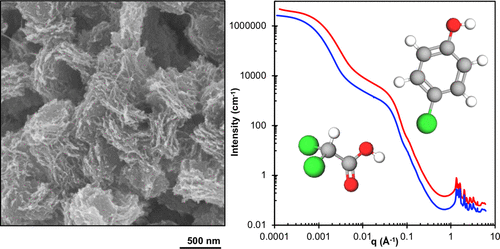当前位置:
X-MOL 学术
›
ACS Appl. Mater. Interfaces
›
论文详情
Our official English website, www.x-mol.net, welcomes your
feedback! (Note: you will need to create a separate account there.)
Hierarchical Morphology of Poly(ether ether ketone) Aerogels
ACS Applied Materials & Interfaces ( IF 8.3 ) Pub Date : 2019-08-05 00:00:00 , DOI: 10.1021/acsami.9b09699 Samantha J. Talley 1 , Stephanie L. Vivod 2 , Baochau A. Nguyen 3 , Mary Ann B. Meador 2 , Aurel Radulescu 4 , Robert B. Moore 1
ACS Applied Materials & Interfaces ( IF 8.3 ) Pub Date : 2019-08-05 00:00:00 , DOI: 10.1021/acsami.9b09699 Samantha J. Talley 1 , Stephanie L. Vivod 2 , Baochau A. Nguyen 3 , Mary Ann B. Meador 2 , Aurel Radulescu 4 , Robert B. Moore 1
Affiliation

|
The phase diagram for the thermoreversible gelation of poly(ether ether ketone) (PEEK) in 4-chlorophenol (4CP) was constructed over broad temperature and concentration ranges, revealing that PEEK is capable of dissolving and forming gels in both 4CP and dichloroacetic acid (DCA) up to a concentration of 25 wt %. Highly porous aerogels of PEEK were prepared through simple solvent exchange followed by one of two drying methods of solvent removal from the wet gel: freeze-drying or supercritical CO2 fluid extraction (SC-drying). The field-emission scanning electron microscopy analysis showed that gelation of PEEK in 4CP, followed by SC-drying, produced aerogels with well-defined lamellar aggregates as compared to less ordered aggregates formed from DCA. Mechanical properties (in compression) were shown to improve with increasing density, resulting in equivalent compressive moduli at comparable density, regardless of the preparation method (gelation solvent selection, concentration variation, or drying method). Nitrogen adsorption–desorption isotherms indicate that PEEK aerogels are comprised of mesopores (2–50 nm diameter pores) formed from stacked crystalline lamella. PEEK aerogels prepared using SC-drying exhibit higher Brunauer–Emmett–Teller surface areas than freeze-dried aerogels of comparable density. The ultra-small-angle X-ray scattering/small-angle X-ray scattering (SAXS)/wide-angle X-ray scattering analysis revealed a hierarchical morphology of the PEEK aerogels with structural features from PEEK crystallites to agglomerates of stacked lamella that spanned a wide range of length scales. SANS contrast-matching confirmed that the morphological origin of the principle scattering feature in PEEK aerogels is stacked crystalline lamella. Nitrogen sorption measurements of porosity and the specific surface area of the PEEK aerogels were correlated with the SAXS analysis to reveal a remarkably high surface area attributed to the platelet-like, lamellar morphology. Contact angle and contact angle hysteresis (CAH) revealed that low-density PEEK aerogels (ρ < 0.15 g/cm3) have water contact angles above the superhydrophobicity cutoff angle (>150°) and a very low CAH near 1°.
中文翻译:

聚醚醚酮气凝胶的分层形态
在较宽的温度和浓度范围内构建了聚醚醚酮(PEEK)在4-氯苯酚(4CP)中热可逆凝胶化的相图,表明PEEK能够在4CP和二氯乙酸中溶解并形成凝胶( DCA)的浓度最高可达25 wt%。PEEK的高多孔性气凝胶是通过简单的溶剂交换,然后是从湿凝胶中去除溶剂的两种干燥方法之一制备的:冷冻干燥或超临界CO 2流体萃取(SC干燥)。场发射扫描电子显微镜分析表明,与由DCA形成的有序聚集体相比,在4CP中PEEK凝胶化,然后进行SC干燥,产生了具有明确层状聚集体的气凝胶。力学性能(压缩时)显示随着密度的增加而改善,无论制备方法(胶凝溶剂选择,浓度变化或干燥方法)如何,均以相同的密度产生等效的压缩模量。氮吸附-解吸等温线表明,PEEK气凝胶由堆叠晶体片形成的中孔(直径为2-50 nm的孔)组成。使用SC干燥制备的PEEK气凝胶比可比密度的冻干气凝胶具有更高的Brunauer-Emmett-Teller表面积。超小角X射线散射/小角X射线散射(SAXS)/广角X射线散射分析揭示了PEEK气凝胶的分层形态,其结构特征从PEEK晶体到叠层薄片的团聚体,涵盖了多种长度标尺。SANS对比度匹配证实,PEEK气凝胶中主要散射特征的形态学成因是堆叠的结晶薄片。氮吸附测量的孔隙度和PEEK气凝胶的比表面积与SAXS分析相关联,显示出归因于血小板状,层状形态的非常高的表面积。接触角和接触角滞后(CAH)表明低密度PEEK气凝胶(ρ<0.15 g / cm SANS对比度匹配证实,PEEK气凝胶中主要散射特征的形态学成因是堆叠的结晶薄片。氮吸附测量的孔隙度和PEEK气凝胶的比表面积与SAXS分析相关联,显示出归因于血小板状,层状形态的非常高的表面积。接触角和接触角滞后(CAH)表明低密度PEEK气凝胶(ρ<0.15 g / cm SANS对比度匹配证实,PEEK气凝胶中主要散射特征的形态学成因是堆叠的结晶薄片。氮气吸附测量的孔隙度和PEEK气凝胶的比表面积与SAXS分析相关联,显示出归因于血小板状,层状形态的非常高的表面积。接触角和接触角滞后(CAH)表明低密度PEEK气凝胶(ρ<0.15 g / cm3)具有超过超疏水性截止角(> 150°)的水接触角和接近1°的非常低的CAH。
更新日期:2019-08-05
中文翻译:

聚醚醚酮气凝胶的分层形态
在较宽的温度和浓度范围内构建了聚醚醚酮(PEEK)在4-氯苯酚(4CP)中热可逆凝胶化的相图,表明PEEK能够在4CP和二氯乙酸中溶解并形成凝胶( DCA)的浓度最高可达25 wt%。PEEK的高多孔性气凝胶是通过简单的溶剂交换,然后是从湿凝胶中去除溶剂的两种干燥方法之一制备的:冷冻干燥或超临界CO 2流体萃取(SC干燥)。场发射扫描电子显微镜分析表明,与由DCA形成的有序聚集体相比,在4CP中PEEK凝胶化,然后进行SC干燥,产生了具有明确层状聚集体的气凝胶。力学性能(压缩时)显示随着密度的增加而改善,无论制备方法(胶凝溶剂选择,浓度变化或干燥方法)如何,均以相同的密度产生等效的压缩模量。氮吸附-解吸等温线表明,PEEK气凝胶由堆叠晶体片形成的中孔(直径为2-50 nm的孔)组成。使用SC干燥制备的PEEK气凝胶比可比密度的冻干气凝胶具有更高的Brunauer-Emmett-Teller表面积。超小角X射线散射/小角X射线散射(SAXS)/广角X射线散射分析揭示了PEEK气凝胶的分层形态,其结构特征从PEEK晶体到叠层薄片的团聚体,涵盖了多种长度标尺。SANS对比度匹配证实,PEEK气凝胶中主要散射特征的形态学成因是堆叠的结晶薄片。氮吸附测量的孔隙度和PEEK气凝胶的比表面积与SAXS分析相关联,显示出归因于血小板状,层状形态的非常高的表面积。接触角和接触角滞后(CAH)表明低密度PEEK气凝胶(ρ<0.15 g / cm SANS对比度匹配证实,PEEK气凝胶中主要散射特征的形态学成因是堆叠的结晶薄片。氮吸附测量的孔隙度和PEEK气凝胶的比表面积与SAXS分析相关联,显示出归因于血小板状,层状形态的非常高的表面积。接触角和接触角滞后(CAH)表明低密度PEEK气凝胶(ρ<0.15 g / cm SANS对比度匹配证实,PEEK气凝胶中主要散射特征的形态学成因是堆叠的结晶薄片。氮气吸附测量的孔隙度和PEEK气凝胶的比表面积与SAXS分析相关联,显示出归因于血小板状,层状形态的非常高的表面积。接触角和接触角滞后(CAH)表明低密度PEEK气凝胶(ρ<0.15 g / cm3)具有超过超疏水性截止角(> 150°)的水接触角和接近1°的非常低的CAH。

































 京公网安备 11010802027423号
京公网安备 11010802027423号